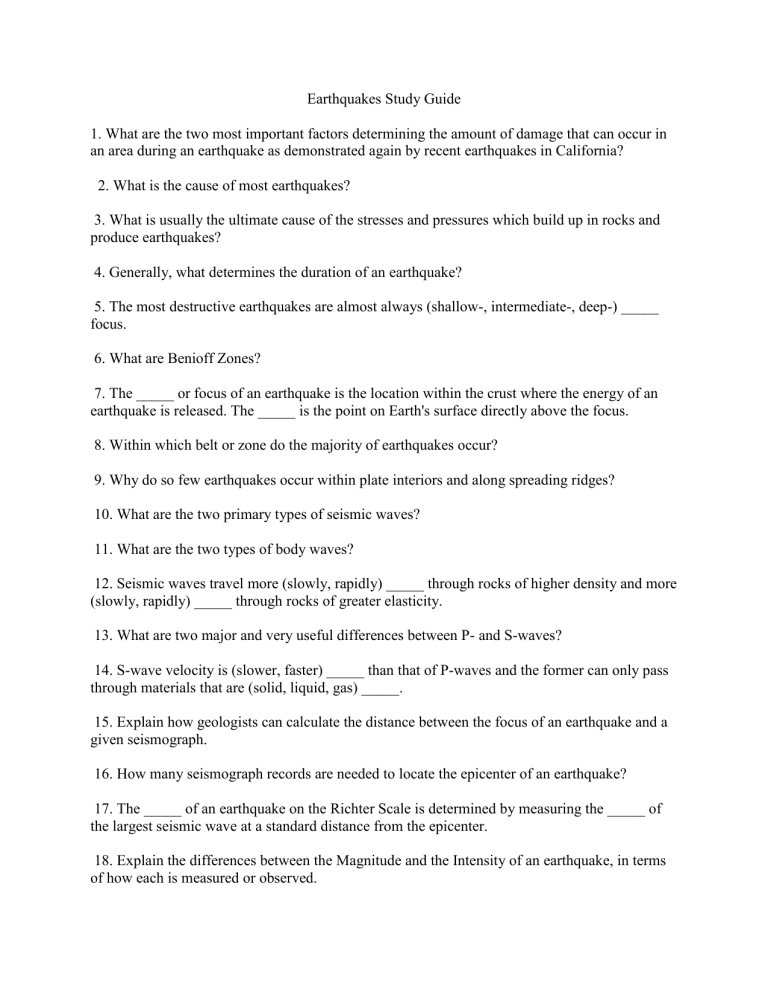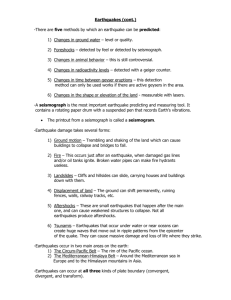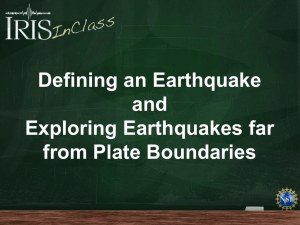Earthquakes Study Guide

Earthquakes Study Guide
1. What are the two most important factors determining the amount of damage that can occur in an area during an earthquake as demonstrated again by recent earthquakes in California?
2. What is the cause of most earthquakes?
3. What is usually the ultimate cause of the stresses and pressures which build up in rocks and produce earthquakes?
4. Generally, what determines the duration of an earthquake?
5. The most destructive earthquakes are almost always (shallow-, intermediate-, deep-) _____ focus.
6. What are Benioff Zones?
7. The _____ or focus of an earthquake is the location within the crust where the energy of an earthquake is released. The _____ is the point on Earth's surface directly above the focus.
8. Within which belt or zone do the majority of earthquakes occur?
9. Why do so few earthquakes occur within plate interiors and along spreading ridges?
10. What are the two primary types of seismic waves?
11. What are the two types of body waves?
12. Seismic waves travel more (slowly, rapidly) _____ through rocks of higher density and more
(slowly, rapidly) _____ through rocks of greater elasticity.
13. What are two major and very useful differences between P- and S-waves?
14. S-wave velocity is (slower, faster) _____ than that of P-waves and the former can only pass through materials that are (solid, liquid, gas) _____.
15. Explain how geologists can calculate the distance between the focus of an earthquake and a given seismograph.
16. How many seismograph records are needed to locate the epicenter of an earthquake?
17. The _____ of an earthquake on the Richter Scale is determined by measuring the _____ of the largest seismic wave at a standard distance from the epicenter.
18. Explain the differences between the Magnitude and the Intensity of an earthquake, in terms of how each is measured or observed.
19. What are tsunami?
20. Why do structures located on thick, soft sediment, especially water-saturated or artificial fill, suffer much greater damage than structures built on bedrock?
21. What causes tsunami?
22. What are three possible precursors for earthquakes?
23. According to the elastic rebound theory
A. rocks will bend before they break.
B. rocks will snap back into their original shape after faulting.
C. rocks will break when their capacity to store energy of deformation has been exceeded.
D. A and C
E. all of the above
24. The angle of dip of a Benioff Zone is a reflection of
A. the presence or absence of a subduction zone.
B. the angle of dip of subducting oceanic crust.
C. the angle of convergence between two descending plates.
D. B and C
E. all of the above
25. Which of the following is not a factor affecting earthquake intensity?
A. distance from the epicenter
B. depth of the hypocenter
C. population density
D. duration of shaking
E. the time elapsed since the last earthquake










